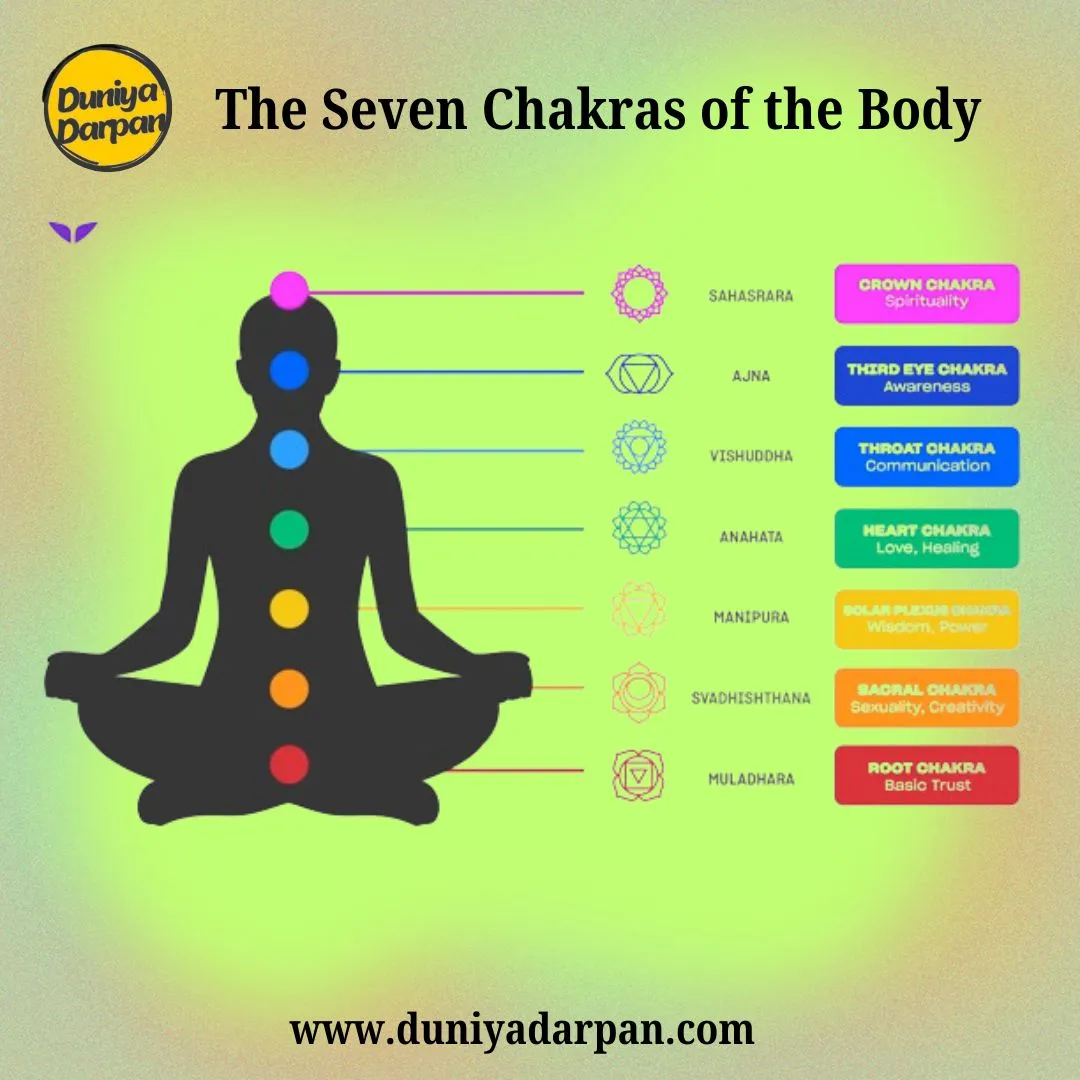From Root to Crown: A Comprehensive Exploration of the Seven Chakras
The concept of seven chakras comes from ancient Indian spiritual traditions. Chakras are seen as spinning wheels of energy located along the spine, each one corresponding to different physical, emotional, and spiritual aspects of our being. Let’s explore these seven chakras and understand how they impact our lives.

1. Root Chakra (Muladhara)
Location: Base of the spine
Color: Red
Element: Earth
Purpose: Foundation and Stability
Symbol: Four-petaled lotus
The Root Chakra is all about feeling grounded and secure. It’s the base upon which we build our life. When balanced, we feel safe, secure, and confident. Imbalances can lead to feelings of insecurity, fear, or physical issues in the legs and feet.
Description: The Root Chakra represents our foundation and feeling of being grounded. It is associated with survival, security, and basic needs like food, shelter, and safety. When balanced, it brings a sense of stability and confidence.
Signs of Imbalance: Feeling insecure, anxious, or fearful; financial instability; physical issues with legs, feet, or lower back.
How to Balance: Practices like walking barefoot on the earth, meditating on the color red, and focusing on stability in daily life can help balance the Root Chakra.
2. Sacral Chakra (Svadhisthana)
Location: Lower abdomen, just below the navel
Color: Orange
Element: Water
Purpose: Creativity and Sexuality
Symbol: Six-petaled lotus
The Sacral Chakra governs our creative and sexual energies. It’s linked to emotions, pleasure, and relationships. When balanced, we feel passionate, creative, and connected. Imbalances may lead to emotional instability, fear of change, or sexual dysfunction.
Description: The Sacral Chakra is the center of creativity, pleasure, and emotions. It influences our desires, relationships, and sexual energy. When balanced, it fosters joy, creativity, and healthy relationships.
Signs of Imbalance: Emotional instability, lack of creativity, sexual dysfunction, or issues with the reproductive organs
How to Balance: Engaging in creative activities, connecting with water (like swimming or taking baths), and eating orange-colored foods can help.
3. Solar Plexus Chakra (Manipura)
Location: Upper abdomen, stomach area
Color: Yellow
Element: Fire
Purpose: Personal Power and Confidence
Symbol: Ten-petaled lotus
The Solar Plexus Chakra is our source of personal power, self-esteem, and confidence. When it’s balanced, we feel self-assured, motivated, and in control. Imbalances can manifest as low self-esteem, anger, or digestive issues.
Description: The Solar Plexus Chakra is the source of personal power, self-esteem, and confidence. It governs our ability to be in control of our lives and make decisions. When balanced, it promotes confidence, motivation, and a strong sense of purpose.
Signs of Imbalance: Low self-esteem, lack of direction, digestive issues, or feeling powerless.
How to Balance: Practicing self-affirmations, engaging in physical exercise, and focusing on personal achievements can strengthen this chakra.
4. Heart Chakra (Anahata)
Location: Center of the chest
Color: Green
Element: Air
Purpose: Love and Compassion
Symbol: Twelve-petaled lotus
The Heart Chakra is the center of love, compassion, and connection. It enables us to love ourselves and others unconditionally. A balanced Heart Chakra fosters empathy, kindness, and inner peace. Imbalances may lead to loneliness, jealousy, or heart-related health issues.
Description: The Heart Chakra is the center of love, compassion, and connection. It governs our ability to give and receive love, forgive, and feel empathy. When balanced, it fosters deep connections and emotional healing.
Signs of Imbalance: Feeling lonely, holding grudges, or experiencing heart or lung issues.
How to Balance: Practicing forgiveness, connecting with nature, and focusing on loving relationships can open and balance the Heart Chakra.
5. Throat Chakra (Vishuddha)
Location: Throat
Color: Blue
Element: Ether (Space)
Purpose: Communication and Truth
Symbol: Sixteen-petaled lotus
The Throat Chakra is all about communication and expressing our truth. It helps us speak honestly and listen effectively. When balanced, we communicate clearly and confidently. Imbalances might cause difficulties in expressing thoughts, throat problems, or social anxiety.
Description: The Throat Chakra is the center of communication, expression, and truth. It influences our ability to speak clearly, listen, and express our thoughts and feelings. When balanced, it enables clear and authentic communication.
Signs of Imbalance: Difficulty expressing yourself, fear of speaking, or throat and neck problems.
How to Balance: Singing, speaking affirmations, and drinking plenty of water can help clear and balance this chakra.
6. Third Eye Chakra (Ajna)
Location: Forehead, between the eyes
Color: Indigo
Element: Light
Purpose: Intuition and Insight
Symbol: Two-petaled lotus
The Third Eye Chakra is the center of intuition, insight, and spiritual awareness. It allows us to see the bigger picture and connect with our inner wisdom. A balanced Third Eye Chakra enhances our intuition and mental clarity. Imbalances can cause headaches, anxiety, or a lack of clarity.
Description: The Third Eye Chakra is the center of intuition, insight, and spiritual awareness. It governs our ability to perceive beyond the physical world and connect with our inner wisdom. When balanced, it enhances intuition and clarity of thought.
Signs of Imbalance: Lack of intuition, difficulty concentrating, or experiencing headaches.
How to Balance: Meditation, visualization exercises, and spending time in silence can help activate this chakra.
7. Crown Chakra (Sahasrara)
Location: Top of the head
Color: Violet or White
Element: Thought
Purpose: Spiritual Connection and Enlightenment
Symbol: Thousand-petaled lotus
The Crown Chakra is our connection to the divine and the universe. It represents spiritual enlightenment and universal consciousness. When balanced, we feel a deep sense of peace and purpose. Imbalances can result in feelings of isolation, disconnection, or mental fog.
Description: The Crown Chakra represents our connection to the divine and the universe. It influences our spiritual growth, enlightenment, and connection to higher consciousness. When balanced, it brings a sense of peace, unity, and spiritual awareness.
Signs of Imbalance: Feeling disconnected from spirituality, lacking purpose, or experiencing confusion.
How to Balance: Practicing meditation, engaging in spiritual practices, and focusing on gratitude can open the Crown Chakra.
Conclusion
Understanding and balancing our chakras can lead to improved physical health, emotional stability, and spiritual growth. By paying attention to each chakra and practicing specific techniques to balance them, we can achieve a more harmonious and fulfilling life. Regular practices such as meditation, yoga, and mindful activities can help keep these energy centers in harmony
The concept of chakras originates from ancient Indian spiritual traditions and is used to describe the energy centers in our body. There are seven main chakras, each corresponding to different physical, emotional, and spiritual aspects of our being. Here’s a simple and easy guide to understanding each chakra.
Follow us on Social Media Page
https://www.instagram.com/p/C9HOVewPJ9m/?hl=en






